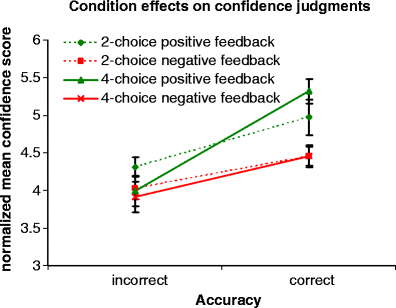Information content and reward processing in the human striatum during performance of a declarative memory task
- PMID: 22194237
- PMCID: PMC3341523
- DOI: 10.3758/s13415-011-0077-3
Information content and reward processing in the human striatum during performance of a declarative memory task
Abstract
Negative feedback can signal poor performance, but it also provides information that can help learners reach the goal of task mastery. The primary aim of this study was to test the hypothesis that the amount of information provided by negative feedback during a paired-associate learning task influences feedback-related processing in the caudate nucleus. To do this, we manipulated the number of response options: With two options, positive and negative feedback provide equal amounts of information, whereas with four options, positive feedback provides more information than does negative feedback. We found that positive and negative feedback activated the caudate similarly when there were two response options. With four options, the caudate's response to negative feedback was reduced. A secondary goal was to investigate the link between brain-based measures of feedback-related processing and behavioral indices of learning. Analysis of the posttest measures showed that trials with positive feedback were associated with higher posttest confidence ratings. Additionally, when positive feedback was delivered, caudate activity was greater for trials with high than with low posttest confidence. This experiment demonstrated the context sensitivity of feedback processing and provided evidence that feedback processing in the striatum can contribute to the strengthening of the representations available within declarative memory.
Figures




Similar articles
-
The neural coding of expected and unexpected monetary performance outcomes: dissociations between active and observational learning.Behav Brain Res. 2012 Feb 1;227(1):241-51. doi: 10.1016/j.bbr.2011.10.042. Epub 2011 Nov 6. Behav Brain Res. 2012. PMID: 22074898
-
Value and probability coding in a feedback-based learning task utilizing food rewards.J Neurophysiol. 2015 Jan 1;113(1):4-13. doi: 10.1152/jn.00086.2014. Epub 2014 Oct 22. J Neurophysiol. 2015. PMID: 25339705 Free PMC article.
-
Dissociation between striatal regions while learning to categorize via feedback and via observation.J Cogn Neurosci. 2007 Feb;19(2):249-65. doi: 10.1162/jocn.2007.19.2.249. J Cogn Neurosci. 2007. PMID: 17280514
-
Manipulating memory efficacy affects the behavioral and neural profiles of deterministic learning and decision-making.Neuropsychologia. 2018 Jun;114:214-230. doi: 10.1016/j.neuropsychologia.2018.04.023. Epub 2018 Apr 26. Neuropsychologia. 2018. PMID: 29705066 Free PMC article.
-
Learning by doing: an fMRI study of feedback-related brain activations.Neuroreport. 2007 Sep 17;18(14):1423-6. doi: 10.1097/WNR.0b013e3282e9a58c. Neuroreport. 2007. PMID: 17712267
Cited by
-
The benefits of negative yet informative feedback.PLoS One. 2018 Oct 19;13(10):e0205183. doi: 10.1371/journal.pone.0205183. eCollection 2018. PLoS One. 2018. PMID: 30339666 Free PMC article.
-
Distinct Reward Properties are Encoded via Corticostriatal Interactions.Sci Rep. 2016 Feb 2;6:20093. doi: 10.1038/srep20093. Sci Rep. 2016. PMID: 26831208 Free PMC article. Clinical Trial.
-
A selective effect of dopamine on information-seeking.Elife. 2020 Dec 2;9:e59152. doi: 10.7554/eLife.59152. Elife. 2020. PMID: 33295870 Free PMC article. Clinical Trial.
-
Signed reward prediction errors drive declarative learning.PLoS One. 2018 Jan 2;13(1):e0189212. doi: 10.1371/journal.pone.0189212. eCollection 2018. PLoS One. 2018. PMID: 29293493 Free PMC article.
-
How may the basal ganglia contribute to auditory categorization and speech perception?Front Neurosci. 2014 Aug 1;8:230. doi: 10.3389/fnins.2014.00230. eCollection 2014. Front Neurosci. 2014. PMID: 25136291 Free PMC article. Review.
References
Publication types
MeSH terms
Substances
Grants and funding
LinkOut - more resources
Full Text Sources

